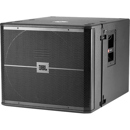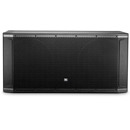
JBL VT4880ADP-DA Full-Size Powered Ultra Long Excursion Dual 18" Arrayable Subwoofer, Integrated Audio System
SKU: JBLV4880ADPD
This item is no longer available.
Recommended Alternatives
Share:
Overview
Compare
Protection
Q&A
Questions & Answers
Reviews about this item
Review Summary
About JBL VT4880ADP-DA Full-Size Powered Dual 18" Arrayable Subwoofer
The JBL VT4880ADP-DA is a versatile, powered integrated audio system with a centrally-vented enclosure housing two 2269G Ultra Long Excursion 18" woofers. JBL DrivePack DP-3 power and DSP electronics package, designed in cooperation with Harman Professional development partners, include patented high efficiency Class-I power amplifier technology and onboard BSS OmniDrive HD digital signal processing that communicates readiness and operational status to the user, while monitoring fault detection of components and electronics.
New ultra long excursion 18" VLF (very low frequency) components, fitted with dual voice coils and robust composite cones, provide high output capabilities and a high power-to-weight ratio. The PlyMax enclosure features foam-backed perforated steel grille, rugged DuraFlex exterior finish and weather resistant speaker cones. Protective end-caps safeguard the suspension hardware while allowing vertical stacking of multiple enclosures on end using integral end mounted, scuff-resistant pads, keyed for aligning surfaces and preventing slippage.
VERTEC suspension systems are engineered for maximum support strength and flexibility. The VT4880ADP-DA's suspension hardware (same as used in the powered full-range VT4889ADP-DA) relies on quick-release pins and end-mounted metal frames to couple adjacent units together in rigid arrays. Suspension frames are made from premium-grade chromoly alloy steel, with plated surfaces; hinge pins are plated and quick-release pin restraining lanyards are stainless steel to resist corrosion. Enclosure ships with integral front and rear hinge bar set (VT4889-RIG).
The low-frequency capabilities of the multi-enclosure VT4880ADP-DA array will be determined by the total number of units coupled. The directivity of a subwoofer line array at any given frequency is proportional to the product of frequency and length of the array. The beam width will be inversely proportional to the product of the array's length and the frequency of interest, typically 20-80 Hz for subwoofer applications. In summary, the more subwoofer elements that are used in the array, the greater directivity will be at lower frequencies, enabling better pattern control. Medium to large arrays can generate extreme amounts of sub-low frequency energy.
Key Features
- JBL DrivePack DP3-electronics package
- World-wide AC line voltages automatically selected for 50 or 60 Hz
- Rugged DuraFlex exterior finish; weatherized loudspeaker cones
- Patented, integrated S.A.F.E. suspension system

